Home » Kitchen Design (Page 2)
Category Archives: Kitchen Design
Builder Confidence Reported Up Despite Market Challenges
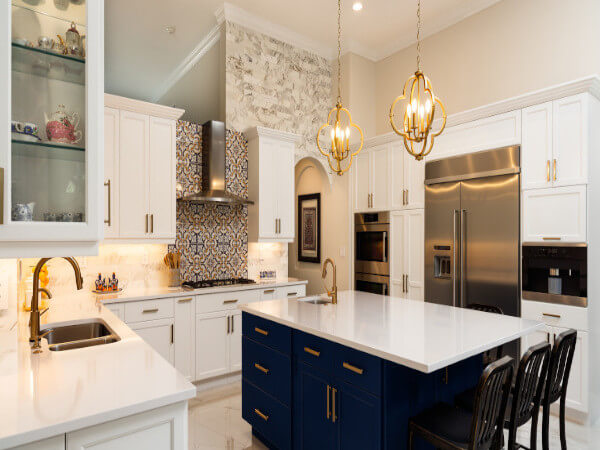
WASHINGTON, DC — Despite inflation concerns and ongoing production bottlenecks, builder confidence edged higher in December for the fourth consecutive month on strong consumer demand and limited existing inventory, the National Association of Home Builders reported.
Builder sentiment in the market for newly built single-family homes moved one point higher to 84 in December, according to the NAHB/Wells Fargo Housing Market Index (HMI), released today.
“While demand remains strong, finding workers, predicting pricing and dealing with material delays remains a challenge,” said NAHB Chairman Chuck Fowke.
“The most pressing issue for the housing sector remains lack of inventory,” observed Robert Dietz, chief economist for the Washington, DC-based NAHB. “Building has increased but the industry faces constraints, namely cost/availability of materials, labor and lots. And while 2021 single-family starts are expected to end the year 24% higher than the pre-Covid 2019 level, we expect higher interest rates in 2022 will put a damper on housing affordability.”
The post Builder Confidence Reported Up Despite Market Challenges appeared first on Kitchen & Bath Design News.
Kitchen of the Month Winner for New Cabinets for November
Kitchen Inspiration by Kitchen Solvers of Eau Claire
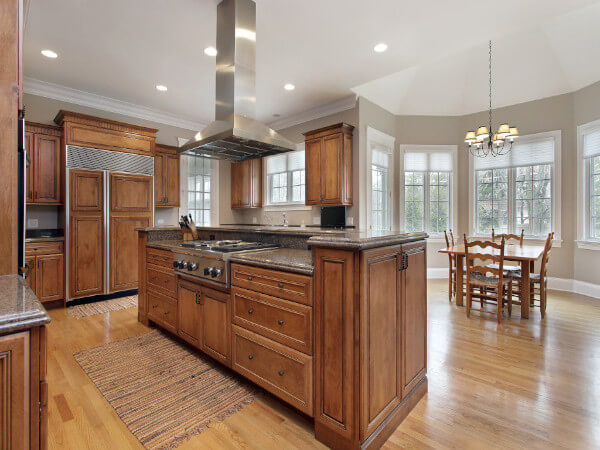
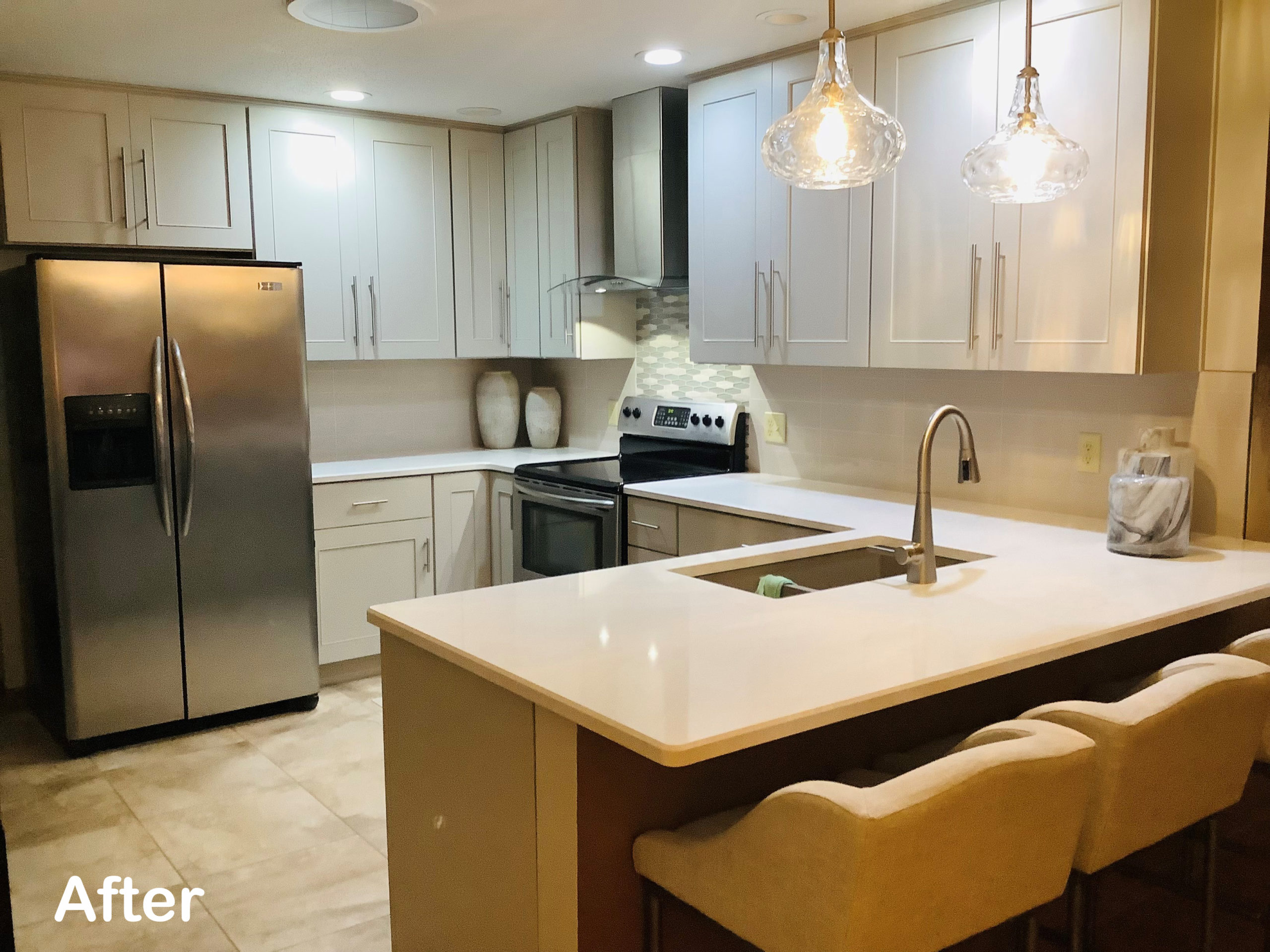
Project Location: Menomonie, WI
Remodel type: New Cabinetry
Type of door style: Kitchen Solvers Classic Collection Bristol
Remodel style: Modern
Color: Boulder
Countertop: Cambria Quartz
Countertop color: Delgado
For more information about this project, please visit Kitchen Solvers of Eau Claire’s Blog.
Find a location near you.
The post Kitchen of the Month Winner for New Cabinets for November appeared first on Kitchen Solvers.
Which Kitchen Layout Suits Your Home Best?
Oftentimes, the remodeling world can be stressful to navigate. With so many options, styles, and designs, it’s hard not to occasionally feel overwhelmed. And along with each decision comes an added price. At Kitchen Solvers, we know a kitchen remodel can be timely and costly. One of the most important aspects of any kitchen is your space’s layout. The layout is what determines how easy your kitchen is to navigate and how convenient it is for both cooking and entertaining. If you want to make sure you get the most out of your kitchen, optimizing all your given space will ensure easy navigation and top convenience. Read below to learn about which kitchen layout suits your home best.

L-Shaped
This layout has become increasingly popular because it offers a very open feel to the kitchen. The L-shaped kitchen has two walls which intersect at a 90-degree angle that feature all the appliances. Often one of the walls is longer than the other to keep space open. Keep in mind working in the kitchen causes you to have your back to the rest of the house, so installing an island can help you prep meals and face people.
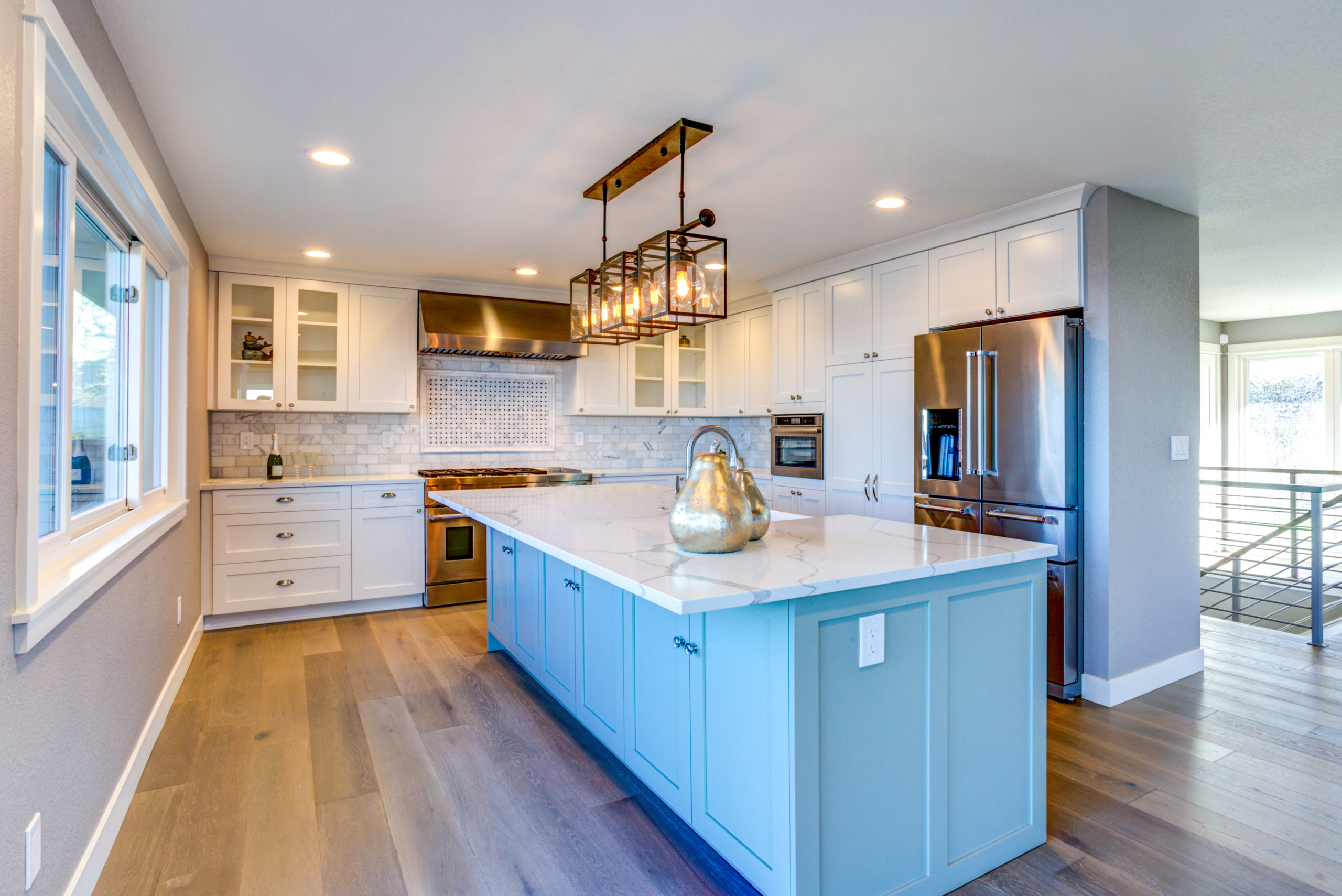
U-Shaped Kitchen
The U-shaped kitchen, also known as the horseshoe layout, adds a third wall to the L-shaped format. This kitchen layout provides workspace on all three sides and gives seamless countertop space. This layout works great in any size kitchen! Normally, homeowners will make the third wall an island or peninsula to help optimize traffic flow.
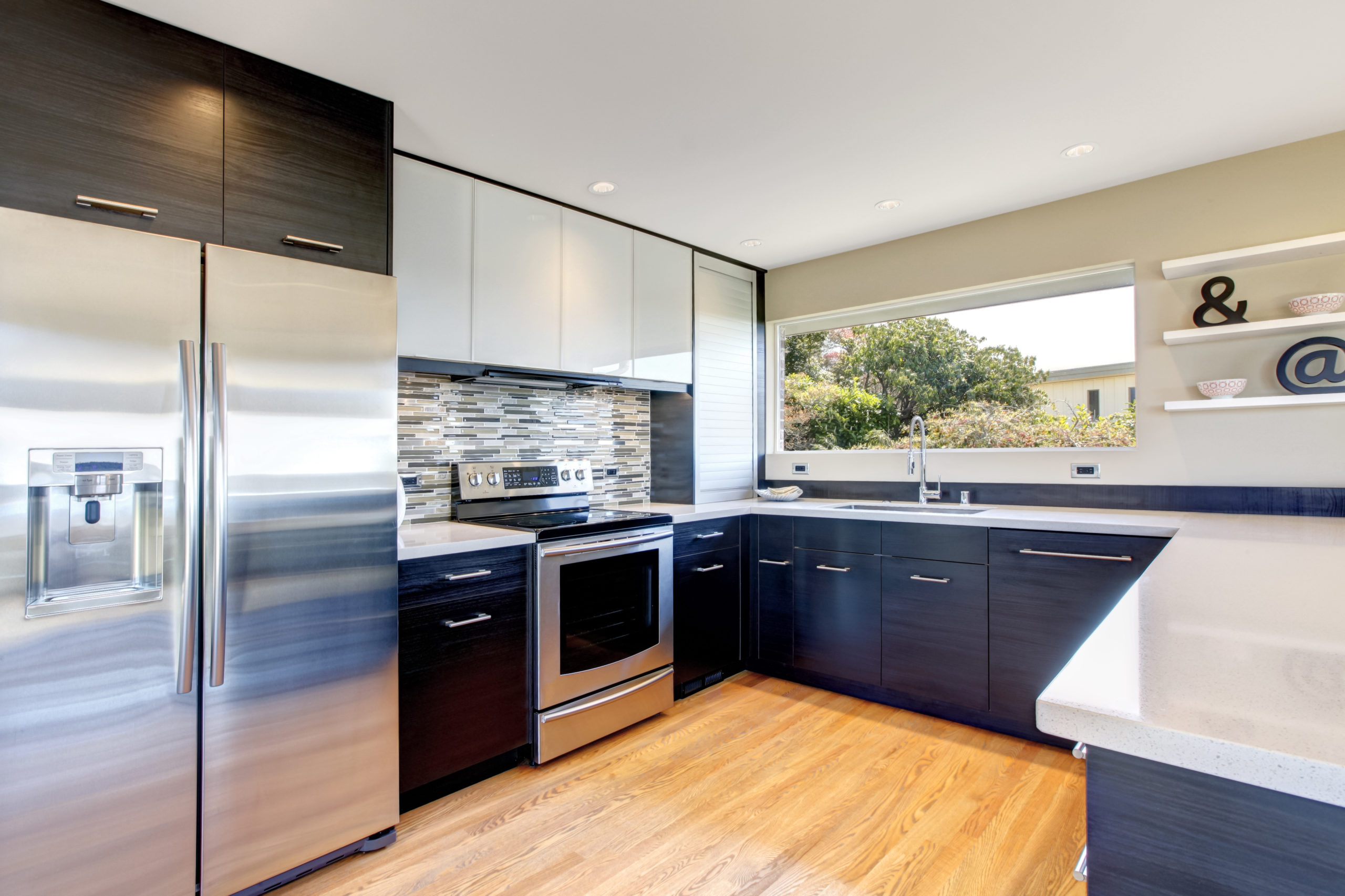
Galley Kitchen
A galley or one-wall kitchen is the most popular layout amongst homeowners because it makes the most out of the available space. A one-wall layout has the appliances and counters all lined up together which makes installation quick and convenient. Most customers choose to have an island compliment this set up to increase counter space and functionality.
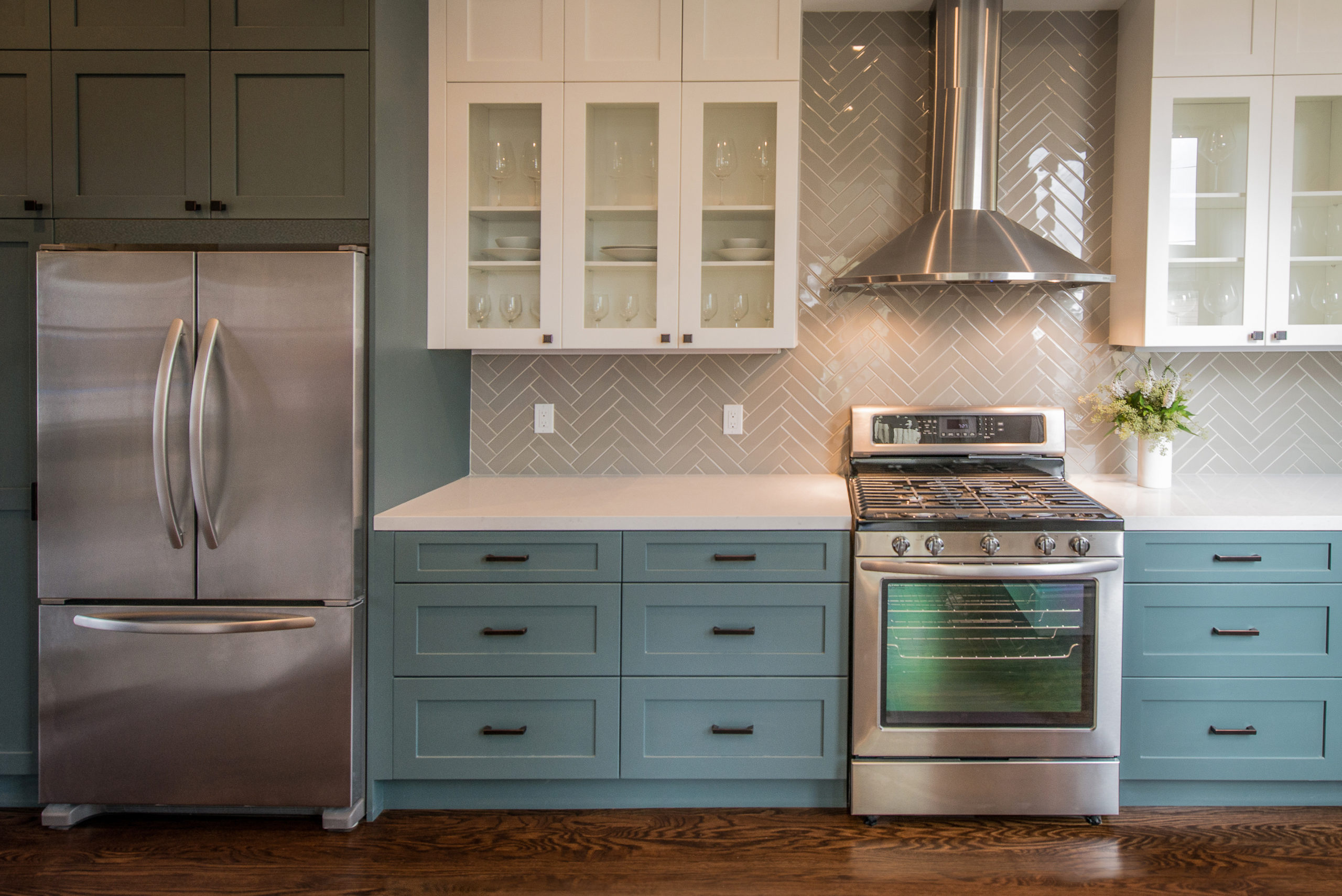
Setting Up Appliances and Sections
When it comes to setting up your appliances and sections, there are a few factors to keep in mind. Each appliance and section has its own traits, and while they often work together with other parts of your kitchen, they still have individual requirements to account for. This is true for appliances like stoves and sinks in addition to sections like cabinets and islands.
Stoves and ovens are an essential aspect of any kitchen, but there’s something important to remember when placing them. To make ventilation easy, or even possible, your stove and oven combo will need to be placed on an exterior wall. Installing ventilation over an island or in the middle of your home can be costly and complicated.
Islands are a common addition to high-end kitchens, but you need to consider where they’re implemented. An island that’s too close to the side of your kitchen will make maneuverability difficult. On the other hand, an island that’s too far away will cease to serve a convenient purpose. It’s just another surface that you must walk all the way over to.
Kitchen Solvers
At Kitchen Solvers, it’s our job to ensure that you have the most Pleasant Remodeling Experience. Making sure you’re constantly blown away by your home is part of our job description. Whether you need storage solutions, a design upgrade, an island installed, a cabinet reface, or want to start from scratch with a whole new kitchen remodel, Kitchen Solvers is here to make your dreams a reality. Also, feel free to check out our blog articles which cover everything from Adding an Easy Color Pop to Your Kitchen! to What is Cabinet Refacing and Why Should I Consider it for My Home?
The post Which Kitchen Layout Suits Your Home Best? appeared first on Kitchen Solvers.
Battling the Supply Chain Woes
Qianyan Cheng has felt the sting of the industry’s historic supply chain disruptions.
The co-founder of INOX – the Sacramento-based supplier of decorative hardware and door locks – Cheng has reported lengthy shipment delays of international goods since the onset of COVID-19. Shipping costs, Cheng tells Kitchen & Bath Design News, have risen exponentially in the face of the public-health crisis. The growing backlog of cargo ships waiting to offload in key ports, she says, has increased more than fourfold in some cases, impacting distribution throughout the company’s worldwide network of upscale hardware showrooms. Related bottlenecks have delayed remodeling and new-construction projects for months – or postponed them entirely.
And Cheng, of course, is far from alone.
Indeed, supply chain disruptions wrought largely by the coronavirus continue to prove a major impediment across virtually all segments of the kitchen and bath industry, including dealers, design firms, manufacturers, importers and building/remodeling construction firms.
In some instances, the supply chain timeline has doubled or tripled due to increased demand coupled with port closures, worker shortages and travel restrictions, as well as vaccine and testing mandates for seafarers, truck drivers and other transport workers. Design firms are witnessing increasing lead times, raw material scarcities and double-digit price hikes for certain products. Labor rates have skyrocketed in the face of worker shortages. Cancellations and postponements have increased, with clients opting to put projects on hold until wait times and costs normalize. At the same time, a sizable number of manufacturers report ongoing capacity restraints, a scarcity of raw materials and the discontinuation of slow-moving product lines to alleviate production constraints.
Equally vexing is the likelihood that the current disruptions will linger well into 2022, and perhaps beyond, despite growing appeals for corrective action.
To wit, the Association of Home Appliance Manufacturers, the organization representing many of the industry’s leading appliance suppliers, last month lent its support to a coalition of trade associations urging government policymakers to address ongoing challenges that business leaders say are damaging the competitiveness of manufacturers, stalling America’s economic recovery and resulting in unprecedented damage to the global product supply chain. AHAM’s call for action, following a similar appeal by the National Association of Home Builders, came one day after a coalition of workers from across the supply chain warned that global trade is facing a potential system collapse if world leaders fail to restore freedom of movement to transport workers.
While some supply chain challenges – such as import tariffs – require long-term, systemic solutions, others can be mitigated by kitchen and bath dealers, designers and remodelers who are willing to temporarily alter their business approach.
For example, many design firms report that they’ve become adaptive to current supply chain challenges, ordering products months in advance to circumvent long lead times and lessen the sting of price hikes. Others say they’ve ordered materials as soon as project contracts are signed, even if a job is weeks out, or have stocked up on commonly used products in an effort to reduce delays. Still others are offering clients alternative products that are easier to obtain or already in stock. Frequent and candid communication regarding extended lead times, back orders and volatility in delivery dates has also become more critical than ever in managing client expectations and preserving relationships, dealers and designers say.
The kitchen and bath design trade has faced a multitude of challenges over the course of its existence. The advent of big box stores and e-commerce has altered the industry’s competitive set. Corporate bankruptcies, ownership changes, factory closures and divestitures have reshaped the manufacturing and retail landscape. Fast-changing lifestyles, homeowner demographics, product introductions and consumer hot buttons have exacerbated the need to stay abreast of what’s going on. Economic downturns have occasionally knocked the industry on its heels.
Astute dealers and designers, for decades, have proven resilient to these and other changes. They’ll doubtless discover ways to survive the current supply chain disruptions, as well. 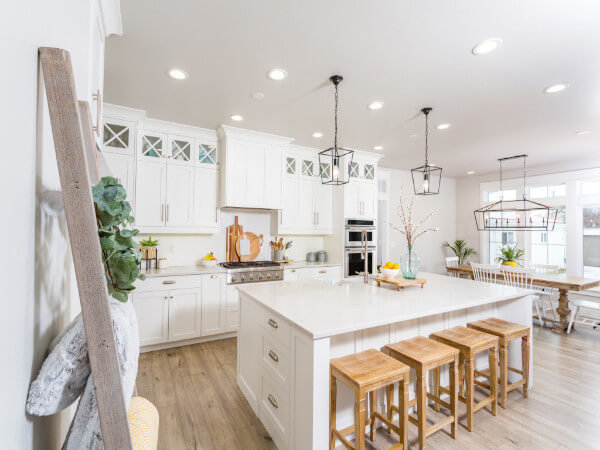
The post Battling the Supply Chain Woes appeared first on Kitchen & Bath Design News.
Did you miss our previous article…
https://www.texaspiekitchen.org/?p=793
Narrow Bath Becomes Soothing Oasis
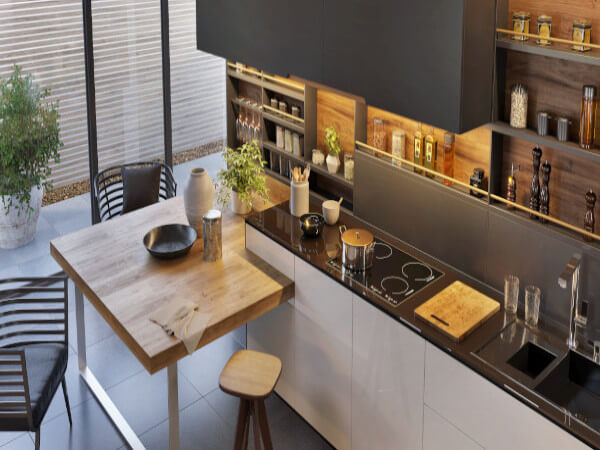 Before
Before
The homeowners, a couple with a toddler, wanted to transform the master bath in their 1950s San Jose home into a soothing spa-like retreat, but the existing space presented quite the challenge – at only 36.5 square feet, the master bath was disproportionately small and cramped.

After Photos: Steven Matthew Solidarios
After
Designer Ratna Mehetre of Hans Spaces LLC incorporated an adjacent hallway linen closet and a small master bedroom closet in order to expand the bathroom’s footprint. The goal of the gut renovation was to create a space that would not only be luxurious, but toddler-proof as well. A new freestanding soaking tub was incorporated into the space, sealed to the wall on one side for safety, along with a custom-built walk-in glass shower with angled custom doors. A vanity was selected that would provide the look of a floating vanity with the added stability of a free-standing vanity. The space is accessible via a pocket door, and there are floor drains outside the shower for easy cleaning. Reflective and cool finishes were selected for the wall and floors in order to create an illusion of additional spaciousness, while a large round rattan mirror provides a feeling of depth.
The post Narrow Bath Becomes Soothing Oasis appeared first on Kitchen & Bath Design News.
Did you miss our previous article…
https://www.texaspiekitchen.org/?p=783
KBIS Returns to Orlando
ORLANDO, FL — Returning to an in-person format, the Kitchen & Bath Industry Show is scheduled to be held February 8-10, 2022 at the Orange County Convention Center in Orlando, FL. Part of Design and Construction Week, KBIS will once again be co-located with the International Builders’ Show.
KBIS and IBS, hosted by the National Kitchen & Bath Association and the National Association of Home Builders, respectively, are expected to feature over 800,000 net square feet of exhibit space and showcase more than 1,000 design and construction brands.
SHOW HIGHLIGHTS
The combined KBIS and IBS events will offer diverse programming, both on and off the show floor, along with a range of new products, technology, demonstrations and networking opportunities.
Some of this year’s highlights include:
- The Kitchen & Bath Design + Industry Awards/Opening Party, dubbed “Night of Elegance,” is scheduled for Monday, Feb. 7 from 6:30 p.m. to 11 p.m. at the Rosen Centre.
- DCW’s Opening Ceremonies, which will take place from 8 a.m. to 9 a.m. on Tuesday, Feb. 8, will feature keynote speaker Earvin “Magic” Johnson.
- Wednesday, Feb. 9 opens with the NKBA State of the Association, scheduled for 8:30 a.m. to 10:15 a.m. The presentation will be followed with the State of the Industry keynote address by Ginny Clarke, Holistic Leadership Strategist and Former Director of Executive Recruiting at Google.
- The second day of KBIS closes with The Bash at Mango’s Tropical Cafe, from 8:30 p.m. to 1:30 a.m., hosted by the NKBA.
EDUCATION & ACTIVITIES
The much-sought-out Voices from the Industry Conference will once again provide educational sessions and workshops, many offering continuing education units (CEUs). Over 80 hour-long informational sessions will offer attendees the chance to hear presentations from industry peers aligned to one of six tracks: Grow Your Business, Kitchen & Bath Specialty Training, Design, Management, Building/Remodeling and Customer Service. Several of the presentations will be hybrid, meaning the sessions can also be accessed online.
Education and information will also be provided through a variety of channels at the show, including:
KBISNeXT Stage, which will showcase the industry’s latest trends and insights shared by leading kitchen and bath experts. Programming includes DesignBites and a series of panel discussions on hot industry topics.
Wellness Pavilion, an area that showcases new and exciting wellness products and education covering themes such as biophilia, technology, lighting and more.
Discovery District, a portion of the South Hall devoted to emerging and international brands. At its center is the Discovery District Lounge, a place to sit, relax, recharge and network.
DCW Outdoor Living Pavilion, South Hall’s segment devoted to new products for grilling, entertaining and living well in a home’s outdoor space.
The ICFF Pavilion brings together brands that feature authentic design, contemporary design and high-end manufacturing. The area is focused on kitchen- and bath-
specific brands including fixtures, hardware, basins, tubs and vanities, as well as furniture, seating, flooring, lighting, materials and accessories.
NKBA Global Connect has an ongoing mission to expand KBIS and NKBA’s international impact, and it will offer curated International Delegation tours, an inaugural Pavilion in South Hall and the launch of the official German Pavilion at KBIS.
Design Milk X Modenus Talks Lounge, a collaboration between Design Milk and Modenus Media, is returning to KBIS for a fifth year and will be located in South Hall near the ICFF Pavilion. For 2022, #dmmtalks will focus on presentations and conversations around design business, emerging designers and artisans as well as networking breakfasts, luncheons and cocktail hours.
DesignBites “speed dating for brands” program returns, showcasing the latest product innovations. Situated on the KBISNeXT Stage, the presentation gives exhibitors the opportunity to share their newest products and programs in a three-minute presentation. 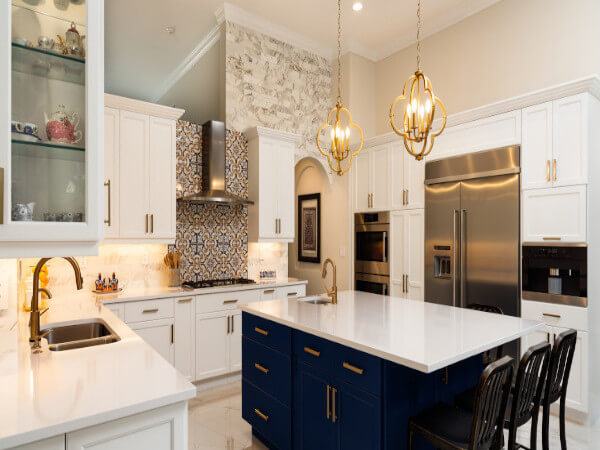
The post KBIS Returns to Orlando appeared first on Kitchen & Bath Design News.
Did you miss our previous article…
https://www.texaspiekitchen.org/?p=777
Elegant Essentials
Beautiful finishes, exquisite detailing and exceptional functionality are all integral to the design of luxury products. The high standards for these products are not only constantly met but exceeded by the companies that produce them.
Choosing the best products introduced into the luxury market is no easy task, but the Decorative Plumbing & Hardware Association assigned a team of industry experts to do just that for its 2021 Product of the Year Awards. The program recognizes uniqueness, design, functionality, innovation and technological superiority and taps the winners in a range of categories. This year’s independent panel of judges included: Mary Jo Peterson, principal, Mary Jo Peterson Design in Brookfield, CT; Eliot Sefrin, founding director and publisher emeritus of Kitchen & Bath Design News; Alissa Ponchione, executive editor at Hospitality Design magazine; Molly Switzer, creator, Molly N. Switzer Designs in Portland, OR, and Alena Capra, owner, Alena Capra Designs in Fort Lauderdale, FL.
Award winners were presented in seven separate categories: Plumbing Fixture, Water Delivery, Furniture, Accessory, Door Hardware, Cabinet Hardware and Technology. The Products of the Year were announced at DPHA’s annual conference and product showcase held this past fall. 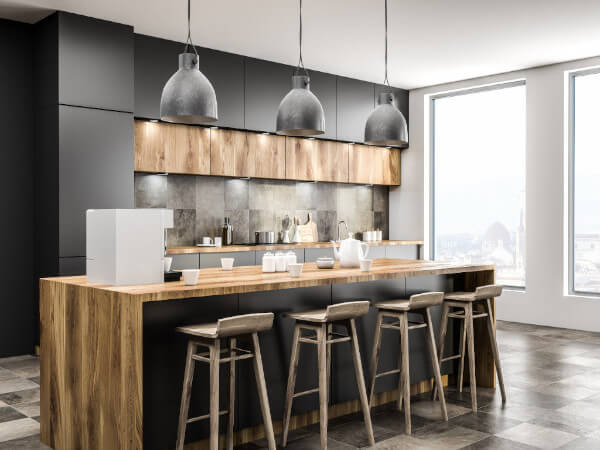
Water Delivery
Winner
Brizo: Frank Lloyd Wright Single-Function Raincan Showerhead
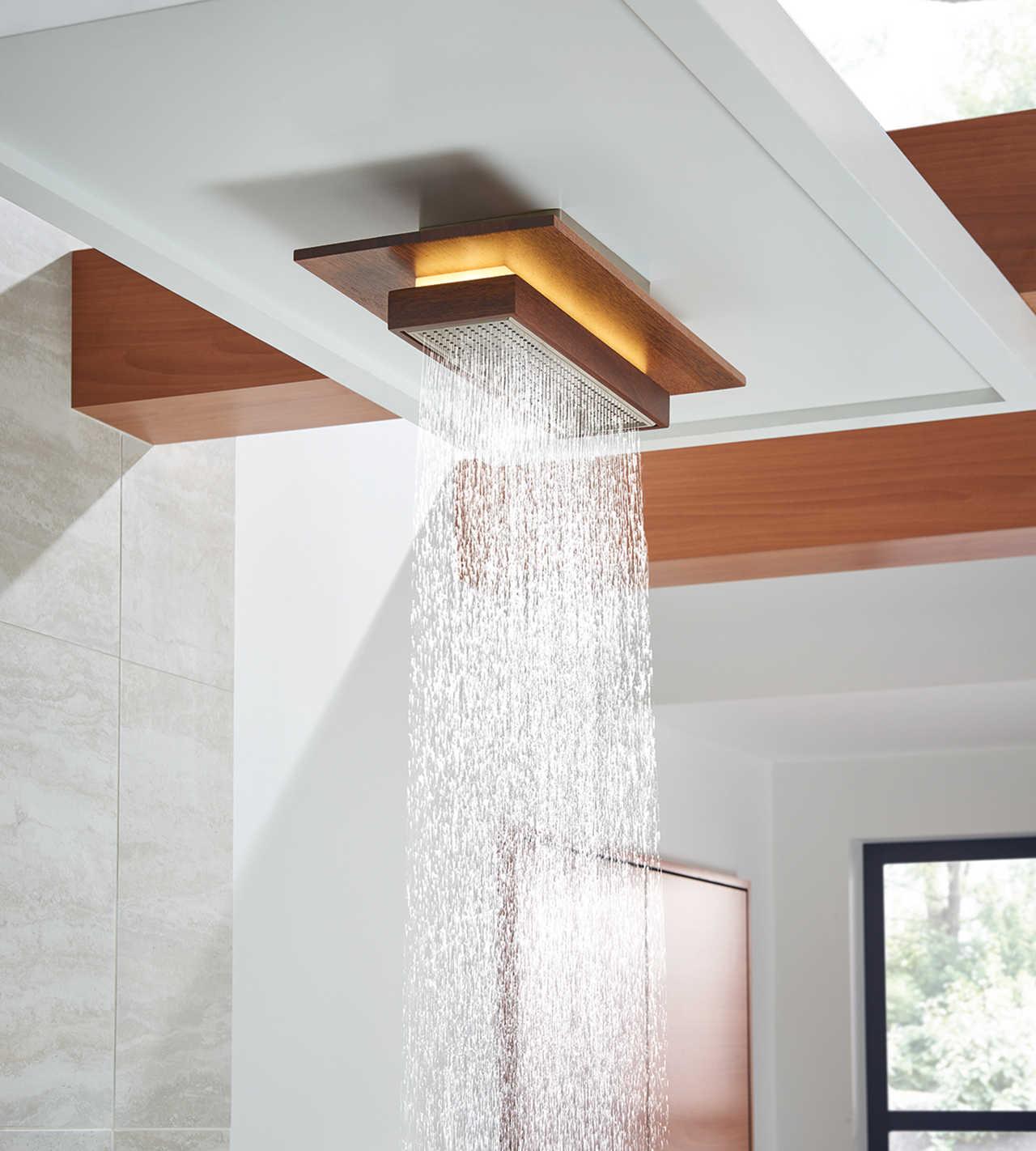 Drawing on the famed architect’s philosophy of organic architecture, Brizo’s Frank Lloyd Wright Single-Function Raincan Showerhead features the distinctive rush of the Canopy Spray, which activates a built-in LED light powered by a hydroge- nator for a dramatic effect. The Spray releases thousands of fine droplets, creating a down- pour that leaves a light tingling sensation. The showerhead can also be surface mounted to the ceiling or pendant mounted on a shower arm. A number of metal finish options highlight the natural beauty of the available wood.
Drawing on the famed architect’s philosophy of organic architecture, Brizo’s Frank Lloyd Wright Single-Function Raincan Showerhead features the distinctive rush of the Canopy Spray, which activates a built-in LED light powered by a hydroge- nator for a dramatic effect. The Spray releases thousands of fine droplets, creating a down- pour that leaves a light tingling sensation. The showerhead can also be surface mounted to the ceiling or pendant mounted on a shower arm. A number of metal finish options highlight the natural beauty of the available wood.
Honorable Mention
California Faucet: Corsano Culinary with Squeeze Handle
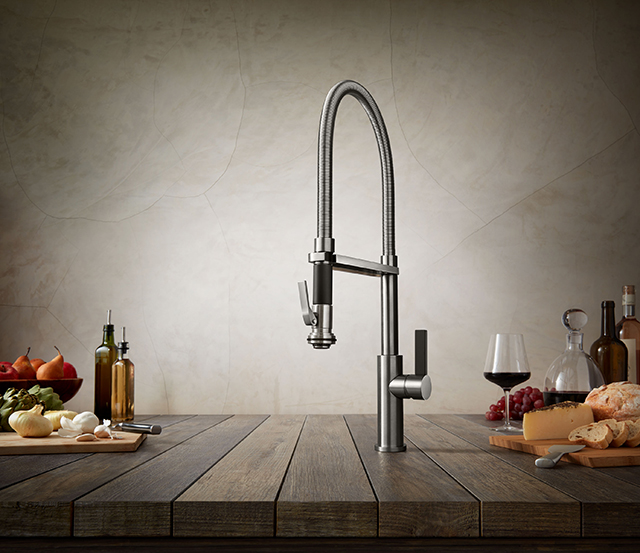 Designed to give cooking enthusiasts a professional look, the Corsano Culinary Faucet with Squeeze Handle includes an easy-to-squeeze lever that activates a powerful spray. Available from California Faucets, the kitchen faucet is offered in 25-plus artisan finishes, plus the ability to finish the coiled spring to match the rest of the faucet. The uniquely engineered insulated sprayhead ensures that it’s never too hot to the touch, even with scalding water. Easy-to-clean spray jets withstand mineral build-up, notes the firm.
Designed to give cooking enthusiasts a professional look, the Corsano Culinary Faucet with Squeeze Handle includes an easy-to-squeeze lever that activates a powerful spray. Available from California Faucets, the kitchen faucet is offered in 25-plus artisan finishes, plus the ability to finish the coiled spring to match the rest of the faucet. The uniquely engineered insulated sprayhead ensures that it’s never too hot to the touch, even with scalding water. Easy-to-clean spray jets withstand mineral build-up, notes the firm.
Accessory
Winner
Sterlingham: Marble Heated Towel Rail
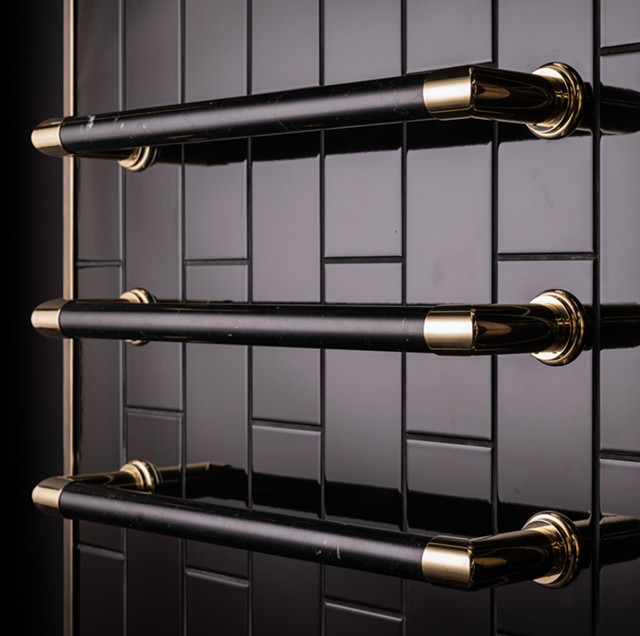 The Sterlingham Co.’s Marble Heated Towel Rail pairs marble with the brand’s signature brassware in a rail designed to gently warm towels. Part of the Cascades Collection, the single rails – which measure nearly 24″ long – may be hung alone or stacked and arranged in nearly any formation. The marble accents are patterned and versatile, and available in five distinctive marbles: Nero Marquina, Bardiglio Nuvolato, Bianco Carrara Venatino, Calacatta Gold Calo-Bett and Giallo Sienna, along with 16 metal finishes.
The Sterlingham Co.’s Marble Heated Towel Rail pairs marble with the brand’s signature brassware in a rail designed to gently warm towels. Part of the Cascades Collection, the single rails – which measure nearly 24″ long – may be hung alone or stacked and arranged in nearly any formation. The marble accents are patterned and versatile, and available in five distinctive marbles: Nero Marquina, Bardiglio Nuvolato, Bianco Carrara Venatino, Calacatta Gold Calo-Bett and Giallo Sienna, along with 16 metal finishes.
Honorable Mention
Infinity Drain: Next Day Custom Linear Program
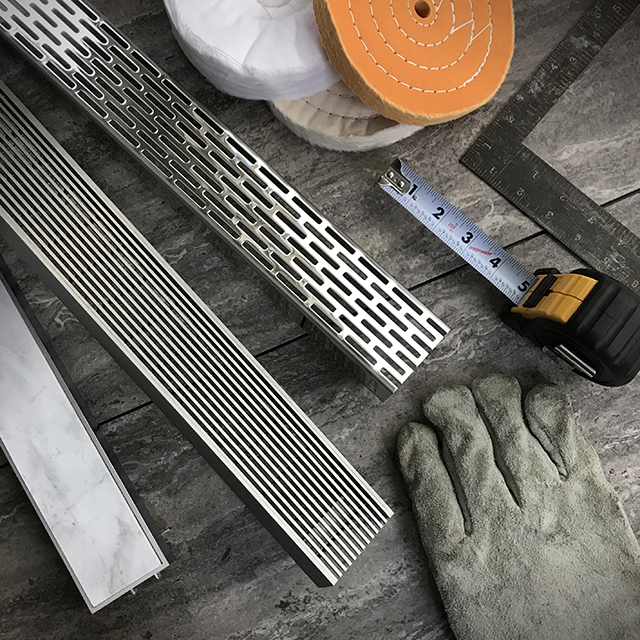 Infinity Drain’s Next Day Custom program eliminates costly and lengthy installation delays by offering custom-sized drains for the shower within a day. Next Day Custom Linear Drains are available in lengths up to 72″ and are offered in two finishes, three grate styles and for all installation waterproofing methods. Custom orders received by 10 a.m. ET ship the following day.
Infinity Drain’s Next Day Custom program eliminates costly and lengthy installation delays by offering custom-sized drains for the shower within a day. Next Day Custom Linear Drains are available in lengths up to 72″ and are offered in two finishes, three grate styles and for all installation waterproofing methods. Custom orders received by 10 a.m. ET ship the following day.
Plumbing Fixture
Winner
MTI Bath: Bowie Freestanding Tub

Featuring pleated exterior detailing, MTI Bath’s Bowie Freestanding Tub adds unexpected texture to the bath. Developed in collaboration with the design firm Source, Bowie is handcrafted from MTI’s SculptureStone material, which is primarily an organic mixture of ground natural minerals and resins that presents the look and feel of molded stone. Bowie provides space for two bathers, is offered as a soaker or air bath and is available in white or biscuit with eight different exterior colors in matte or highly polished gloss finishes.
Honorable Mention
Native Trails: Amara Fireclay Sinks
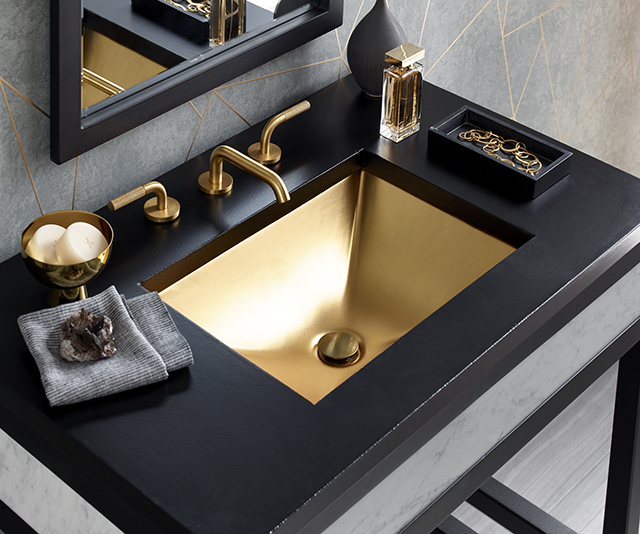 Handcrafted by Italian artisans, Amara fireclay sinks from Native Trails feature a rectangular profile glazed in 24k gold, platinum and silver in honor of the company’s silver anniversary. The sink is created from rich clay soils sourced from the Umbrian region of central Italy that are molded using ancient ceramic techniques dating back to the Bronze age. The sinks can be installed as drop-in or undermount, and deliver a stain-resistant, non-toxic coating that resists tarnishing and fingerprints.
Handcrafted by Italian artisans, Amara fireclay sinks from Native Trails feature a rectangular profile glazed in 24k gold, platinum and silver in honor of the company’s silver anniversary. The sink is created from rich clay soils sourced from the Umbrian region of central Italy that are molded using ancient ceramic techniques dating back to the Bronze age. The sinks can be installed as drop-in or undermount, and deliver a stain-resistant, non-toxic coating that resists tarnishing and fingerprints.
Furniture
Winner
Stone Forest: Elemental Crossbar
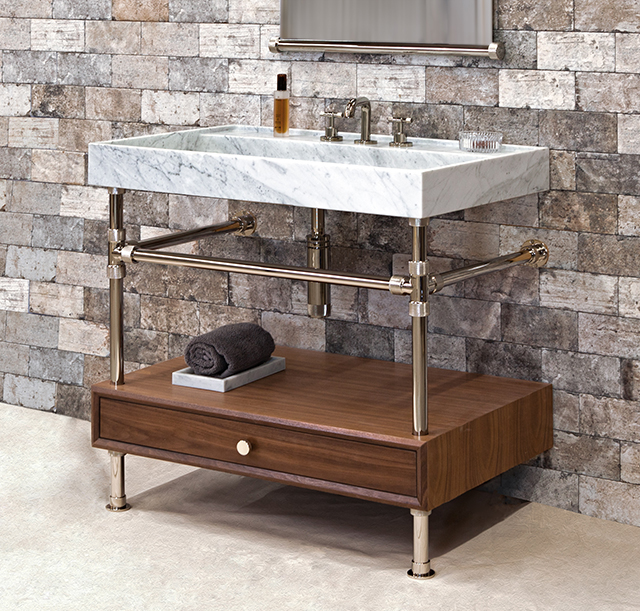 Designed for the bath, Stone Forest’s Elemental Crossbar uses a locking collar system that affords the flexibility to customize each setup to suit individual needs and preferences. The knurled locking collar supports modular components at desired heights on the brass pipe legs for seemingly endless options. Elemental Crossbar allows users to combine integral stone sinks, wood drawers and steel, wood or stone shelving in various combinations. It is available in all finishes, including a new walnut finish option for drawers and shelves.
Designed for the bath, Stone Forest’s Elemental Crossbar uses a locking collar system that affords the flexibility to customize each setup to suit individual needs and preferences. The knurled locking collar supports modular components at desired heights on the brass pipe legs for seemingly endless options. Elemental Crossbar allows users to combine integral stone sinks, wood drawers and steel, wood or stone shelving in various combinations. It is available in all finishes, including a new walnut finish option for drawers and shelves.
Honorable Mention
AD Waters/Simas: Agile Vanity
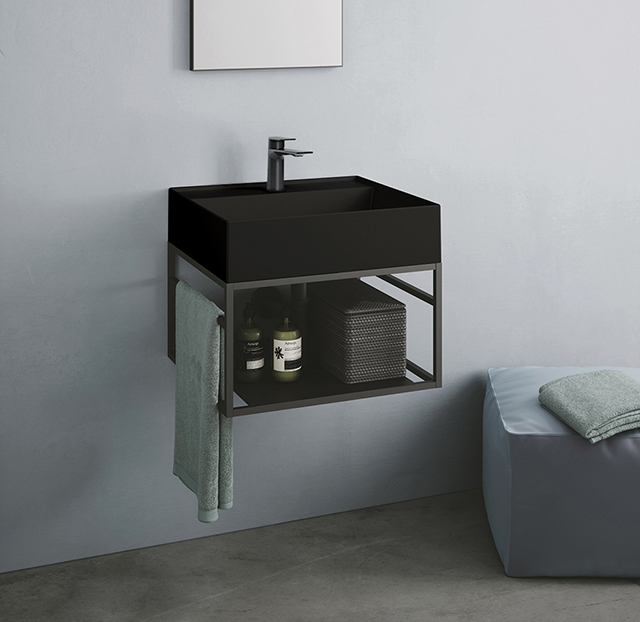 Handcrafted in Italy, the Agile wall-hung console vanity from Simas exhibits clean lines and squared-off edges that evoke both simplicity and purity. Available in the U.S. from AD Waters, the piece includes a washbasin fashioned from Italian porcelain, showcasing craftsmanship and cultural authenticity. Agile is available in eight colors.
Handcrafted in Italy, the Agile wall-hung console vanity from Simas exhibits clean lines and squared-off edges that evoke both simplicity and purity. Available in the U.S. from AD Waters, the piece includes a washbasin fashioned from Italian porcelain, showcasing craftsmanship and cultural authenticity. Agile is available in eight colors.
Door Hardware
Winner
Accurate Lock & Hardware: SmartEntry, Self-Latching Mortise Lock
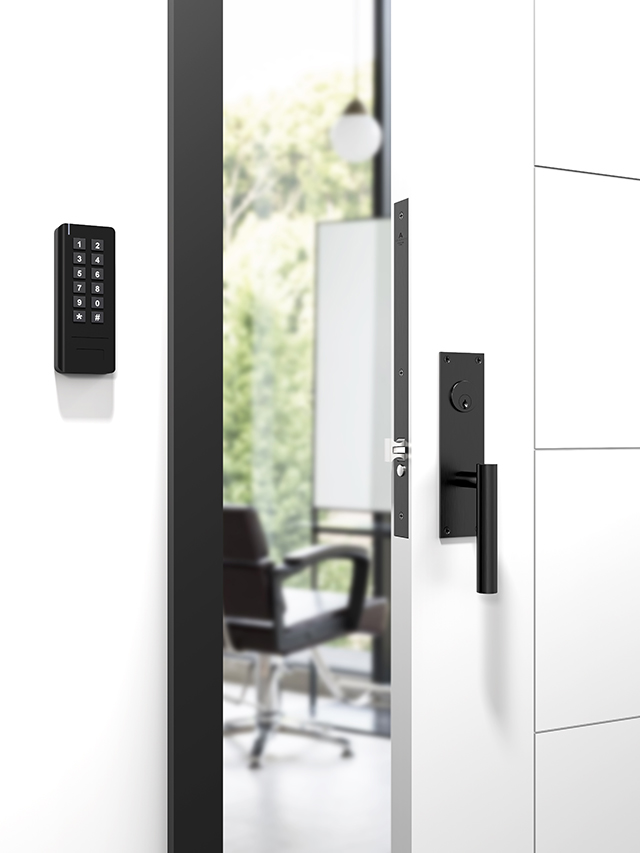 The SL-SM9159E brings the convenience of smartphone locking control to space-saving sliding and pocket doors. The lock, from Accurate Lock & Hardware, combines mechanical expertise with cutting-edge technology. Paired with the SL9100 Self-Latching Mortise Lock, it is available with a variety of trim options including Sectional Trim (lever and rose), ADA Trim (lever and escutcheon) or Flush Pull Trim for Pocket Doors.
The SL-SM9159E brings the convenience of smartphone locking control to space-saving sliding and pocket doors. The lock, from Accurate Lock & Hardware, combines mechanical expertise with cutting-edge technology. Paired with the SL9100 Self-Latching Mortise Lock, it is available with a variety of trim options including Sectional Trim (lever and rose), ADA Trim (lever and escutcheon) or Flush Pull Trim for Pocket Doors.
Honorable Mention
OMNIA Industries: L.D12943 Smart Lock
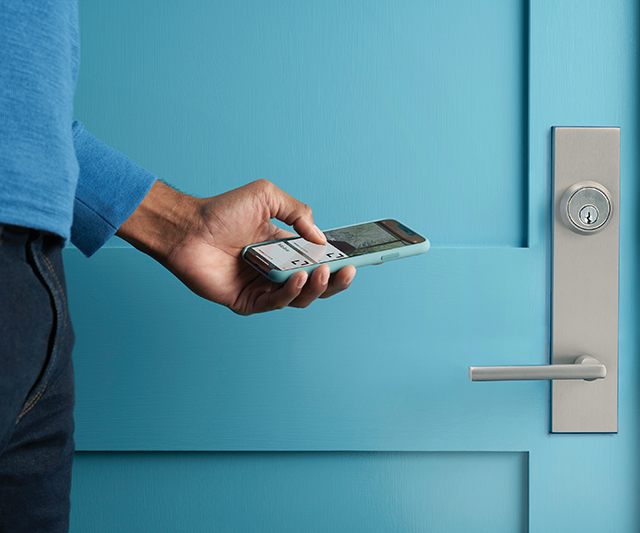 OMNIA Industries has partnered with Level to deliver smart deadbolt locksets, including the L.D12943 Smart Lock. The hardware designs are crafted in the Italian tradition and powered by the Level Bolt invisible smart lock. Level Bolt is powered by one CR2 lithium battery and works with the Level app to provide safe and secure keyless entry. Users can automatically lock and unlock a door, see who’s come and gone, access from anywhere, use with other devices, control with voice, create home automations and more.
OMNIA Industries has partnered with Level to deliver smart deadbolt locksets, including the L.D12943 Smart Lock. The hardware designs are crafted in the Italian tradition and powered by the Level Bolt invisible smart lock. Level Bolt is powered by one CR2 lithium battery and works with the Level app to provide safe and secure keyless entry. Users can automatically lock and unlock a door, see who’s come and gone, access from anywhere, use with other devices, control with voice, create home automations and more.
Technology
Winner
Airmada: Shower Drying System
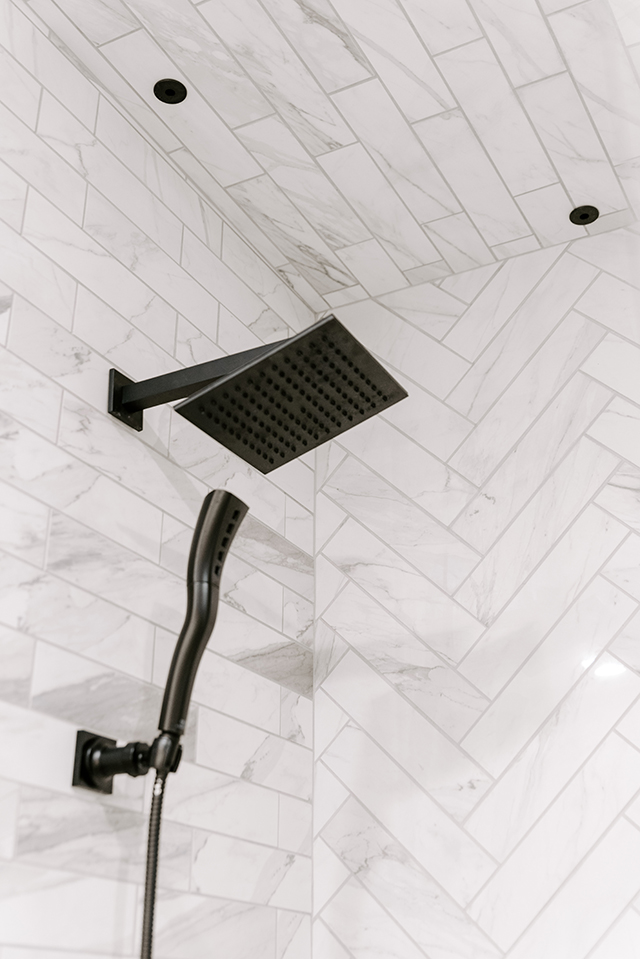 The patented Airmada Shower Drying System prevents mold, mildew, slippery floors and after-shower humidity, reduces watermarks, and the need to use harsh cleaning chemicals, notes the company. With the push of a button, air flows into the space from Air-Jet nozzles installed into the walls and ceiling. Installed at rough in, nozzles are placed throughout the shower space, typically in the ceiling, on the wall above any benches and low on walls to dry across the floor. An array of finishes to match tile, and complement other features, is offered.
The patented Airmada Shower Drying System prevents mold, mildew, slippery floors and after-shower humidity, reduces watermarks, and the need to use harsh cleaning chemicals, notes the company. With the push of a button, air flows into the space from Air-Jet nozzles installed into the walls and ceiling. Installed at rough in, nozzles are placed throughout the shower space, typically in the ceiling, on the wall above any benches and low on walls to dry across the floor. An array of finishes to match tile, and complement other features, is offered.
Honorable Mention
ThermaSol: HydroVive

ThermaSol’s HydroVive is designed to bring the multi-sensory powers of light, sound and water under the user’s control when paired with ThermaSol’s Smart Shower Valve and ThermaTouch interface. Key features include a ceiling-mounted light, sound and rainhead environment system in one module; a rainhead shower that delivers a gentle falling water sensation with 300 neoprene jets; sound settings that include volume, treble, mid-range and bass; stereo RCA input; 200 full-color spectrum luminous LED, and built-in Bluetooth.
Cabinet Hardware
Winner
Waterstone Faucets: Industrial Appliance Pulls
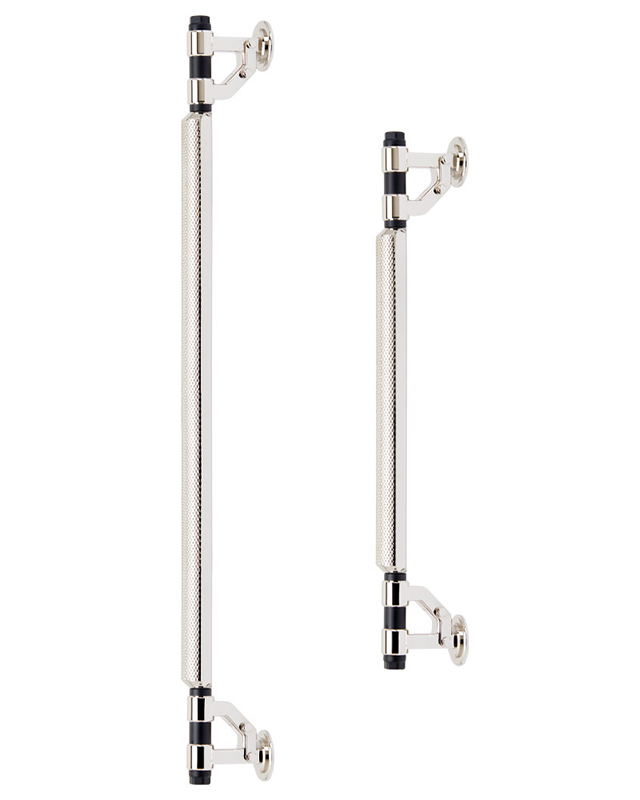 Inspired by the company’s Industrial Contemporary bath collection, the Industrial Appliance Pulls and cabinet hardware from Waterstone Faucets feature diamond knurling detailing. Fashioned from U.S. solid brass bar stock, the hardware features more of an oval shape for a comfortable feel in the hand. There is no knurling on the underside, which adds to the smooth aesthetic. Split finish designs are available.
Inspired by the company’s Industrial Contemporary bath collection, the Industrial Appliance Pulls and cabinet hardware from Waterstone Faucets feature diamond knurling detailing. Fashioned from U.S. solid brass bar stock, the hardware features more of an oval shape for a comfortable feel in the hand. There is no knurling on the underside, which adds to the smooth aesthetic. Split finish designs are available.
Honorable Mention
Turnstyle Designs: Hickory
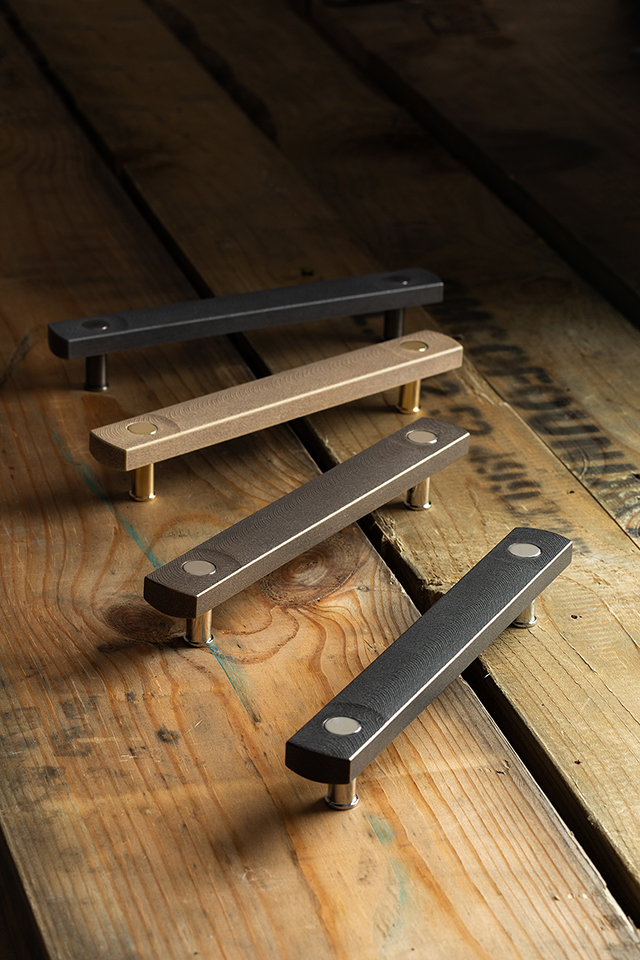 Inspired by North American hunting knives, the Hickory lever, pull handle and cabinet knob are hand-cast in Turnstyle Designs’ Amalfine material, which preserves the fine details of the timber and wood grain design. Available in 48 combinations of Amalfine and solid brass, the pieces are set on a solid brass plate or strip and have a circular button. The circular buttons are a take on a nail, creating a contrast between the smooth brass finish and the textured Amalfine surface.
Inspired by North American hunting knives, the Hickory lever, pull handle and cabinet knob are hand-cast in Turnstyle Designs’ Amalfine material, which preserves the fine details of the timber and wood grain design. Available in 48 combinations of Amalfine and solid brass, the pieces are set on a solid brass plate or strip and have a circular button. The circular buttons are a take on a nail, creating a contrast between the smooth brass finish and the textured Amalfine surface.
The post Elegant Essentials appeared first on Kitchen & Bath Design News.
Did you miss our previous article…
https://www.texaspiekitchen.org/?p=760
Scenes from supersalone
Though this fall’s gathering at Salone in Italy was an abbreviated version of the annual event, visitors were wowed by what they saw and got a taste of what is to come. According to Maria Porro, the new president of Salone del Mobile.Milano, supersalone was not to be viewed as a smaller event, but rather as a special edition of the massive event – “the trade show reimagined.”
Held in September at the Rho Fairgrounds in Milan, the whole show – which was planned over the course of three months – had a different vibe than its predecessors. Held in just four exhibit halls, booths were scaled down and encouraged to follow an “art gallery” theme, allowing visitors to view displays from a comfortable distance if preferred. All surrounding rest and eating areas were fabricated from raw wood, a commitment to sustainability that allowed all of the materials to be disassembled and used again.
More than 60,000 attendees walked the floor, 30 percent of them from 113 countries other than Italy. All attendees adhered to a strict COVID-19 protocol, which included a check of vaccination cards or COVID testing at the gate and masks worn within the halls. Exhibitors included 425 brands, 18 percent of which were from countries other than Italy.
The new Salone del Mobile.Milano digital platform also played a decisive role during the event, used by an unprecedented number of visitors both at the fair and remote, noted show organizers.
“It was important to take that first but decisive step, to make our presence felt and send a signal to the country as a whole,” stated Porro. “Deciding to go ahead with this ‘supersalone’ took a good dose of courage and meant taking on a lot of responsibility – for the system as a whole and for the entire supply chain, which needed a physical and concrete occasion, not just symbolic and digital, to press the accelerator for a restart.” She added that the show organizers will use what they learned from this event to discover what works and what doesn’t, as well as what is missing. The result will be reflected in the full-sized 60th edition of Salone del Mobile.Milano, planned for April 5-10, 2022. 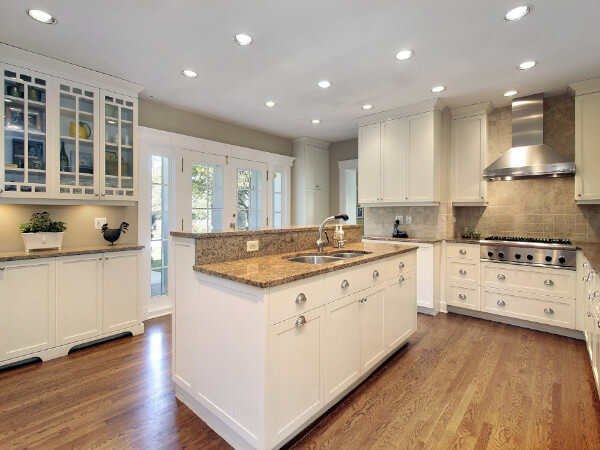
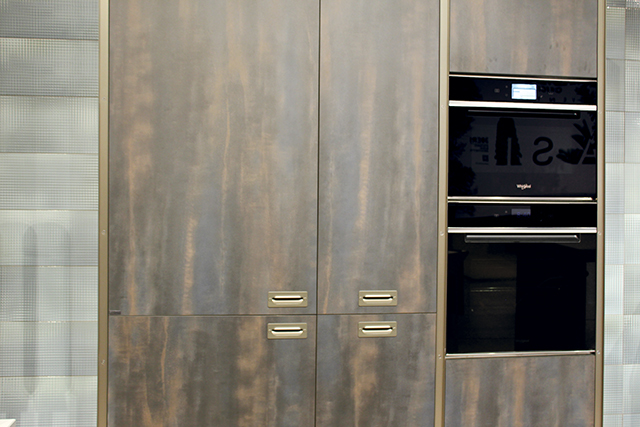
Scavolini
Photos: Cammi Shaw
TREND: Metallic Finishes, Textured Finishes, Bold Colors
Cabinets got new life, with textured finishes, bright colors and matte surfaces among the displays. Metallic looks drew significant attention for cabinets, with copper tones and patinated metal looks interpreted on doors and drawers. Bright colored surfaces made bold statements in a number of other product categories.
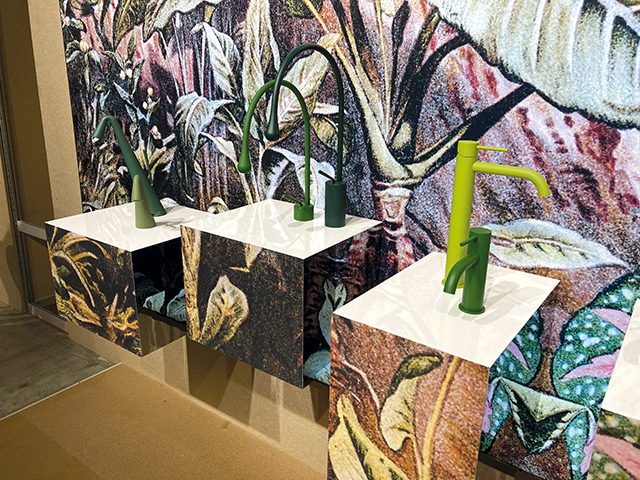
Products Inspired by Nature
Booths and products embraced the great outdoors, with bold prints and natural settings acting as backdrops to earthy colors and nature-inspired products. Weathered woods, rugged stones and all things green were front and center, including a tree that acts as the focal point of the kitchen.
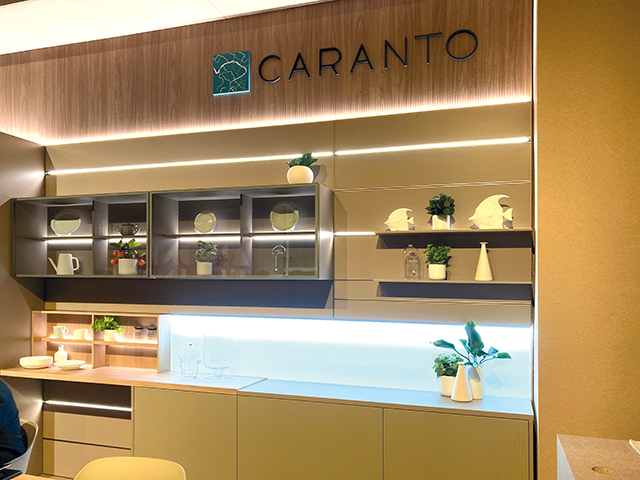
Caranto
Stylish Storage
The juxtaposition of open display and hidden spaces was a key theme on the show floor. Beautifully lit shelving and glass-front cabinets with modern trim were prevalent, providing opulent opportunities to show off prized possessions. Just as captivating was the clever and discreet storage, or the kitchens that disappeared completely behind elegant doors and sliding countertops.
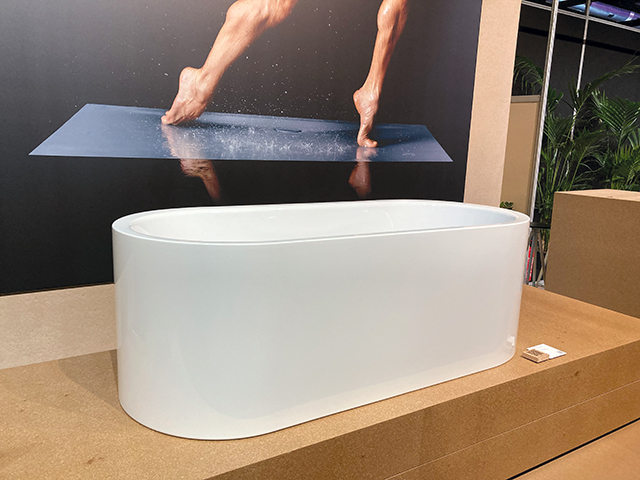
KALDEWEI
Spa Products
In an atmosphere of safety, wellness continued to be top of mind, and products on the show floor did not disappoint. Whether the interest was in totally decked-out pampering with custom designs or a more whimsical take on taking care, a range of products were examined and noted by show attendees.
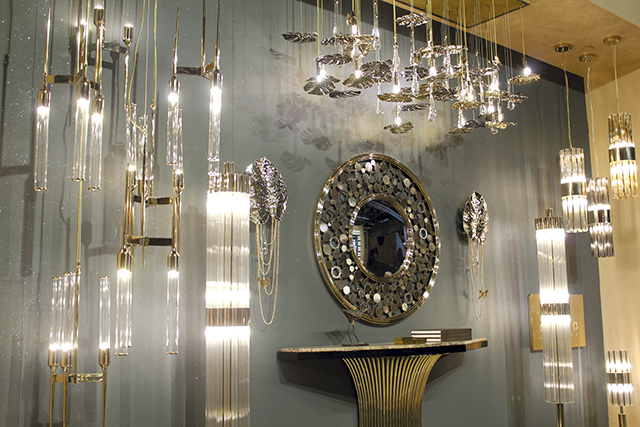
Castro Lighting
Lighting it Up
Accessories and lighting delivered a modern vibe, with LEDs expanding the scope of what is possible in design. The finishing touches to any space, on display were products that can add significant impact or just the right element to complete a room.
The post Scenes from supersalone appeared first on Kitchen & Bath Design News.
Did you miss our previous article…
https://www.texaspiekitchen.org/?p=737
The Art of Japandi
Sometimes two great styles are better than one. That’s what happens when the raw functionality of Scandinavian design fuses with Japanese nature-suffused simplicity, and it’s a look that fits American kitchens like a glove. Designers say it creates wonderful zen, with some famous Scandi and Japanese variants adding warmth and interest to sleek minimalism.
At first glance it may seem an unlikely design union, since Japan and Scandinavia are on opposite sides of the globe. But, in actuality, their design sensibilities are remarkably similar, and Denmark, especially, has had a close trade relationship with Japan for hundreds of years. The Danish design museum in Copenhagen even devotes exhibit space to Japanese design.
Thomas Lykke of OEO Studio in Copenhagen, Tokyo and Kyoto applauds the design fusion of the two countries, but dislikes that it’s dubbed a trend.
“Trends tend to pass by,” he says. “The Japanese-Danish connection goes far beyond that. I call it shared DNA. Meticulous craftsmanship and attention to details, simplicity and timelessness are deep-rooted in both countries’ culture. We want design that will be relevant 50 years from now. And we are, in our hectic lives, looking for meaningful ways to live, through craftsmanship and rituals, whether that’s a tea ceremony in Kyoto or a coffee break in Copenhagen. Also, neither country has vast natural resources, so we respect what we have and work with it.”
Although Japandi at its roots is the epitome of minimalism, two special concepts set it apart. One is “hygge,” a Danish word now known by designers everywhere, meaning cozy comfort. In Scandinavia this is achieved with lots of textures and touches of color. The other is wabi sabi, the Japanese concept of finding beauty in something imperfect. This could be a well-loved heirloom, perhaps a piece of furniture or a well-used utensil. Although Scandinavians don’t talk about wabi sabi, they, too, love to let the patina of something old and well-loved add charm to a space.
Cabinetry in a Lykke kitchen is always the main event. In one kitchen, for example, cabinets aspire to be more a piece of furniture that fits naturally into living environments rather than a stand-alone kitchen. It combines simplicity and refined, contrasting materials. Lykke calls it “a quality culinary space rather than merely a show kitchen.” Another kitchen features modular cabinets, a popular concept in European homes. The modules are sectioned using slender metal dividers and sit on metal plinths creating a light, floating look.
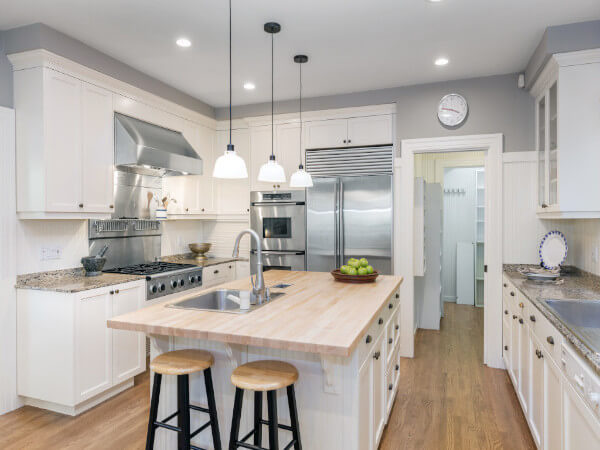
A tiny concrete cave of a New York City apartment is turned into a work of art by architect Andrew Mikhael, who used walnut not just for cabinetry but also for structural elements. The concrete ceiling couldn’t accommodate recessed lighting, so he installed LED tape lights in channels and then surrounded them with walnut slats. The angled walnut wall was designed to reference a drawn-back curtain revealing the sculptural space.
Modern Nostalgia
When a 30-something guy bought a tiny, concrete cell of an apartment on New York City’s Upper East Side, he turned to architect Andrew Mikhael for help. The client showed Mikhael photos from his grandmother’s home, a place that inspired wonderful memories. When Mikhael saw the grandmother’s Danish serve ware and the simple, elegant mid-century furnishings, he knew exactly what to do.
“Since he loves to have people over and cook and bake for them, I knew the kitchen should be an unexpected centerpiece,” reports Mikhael, “a functional work of art. We removed the wall between the galley kitchen and the living room to combine the spaces. We also extended the kitchen into the entryway space, thus expanding the kitchen from 56 square feet to 87 square feet. Next, we installed an angled walnut wall that recalls a partially pulled-back curtain, dramatically revealing the sculptural kitchen.”
Mikhael used walnut throughout the kitchen as an homage to the client’s grandmother. He even wrapped a structural column that couldn’t be moved in walnut. The remarkable workmanship morphs and blends, wraps and anchors, and ultimately hammers out a rhythm.
Lighting was a problem in the apartment. “Because the ceilings were concrete, lighting couldn’t be recessed into them,” explains Mikhael. “As a result, LED tape lights were mounted in long channels one inch below the ceiling, and we then used wood slats to give them a home. The slats don’t just shield the lighting channels, they also hide the unsightly concrete.”
Cabinetry is frameless with simple finger pulls to keep the look minimalist, countertops are matte black Corian, the range and hood are wrapped in stainless steel, and backsplashes are backlit glass.
Mikhael warns that a meticulous carpenter is needed for this kind of work. “I asked my contractor if he minded if I worked with the carpenters at Conex Interiors directly,” he relays, “and he gave me his blessing. They did an incredible job.”
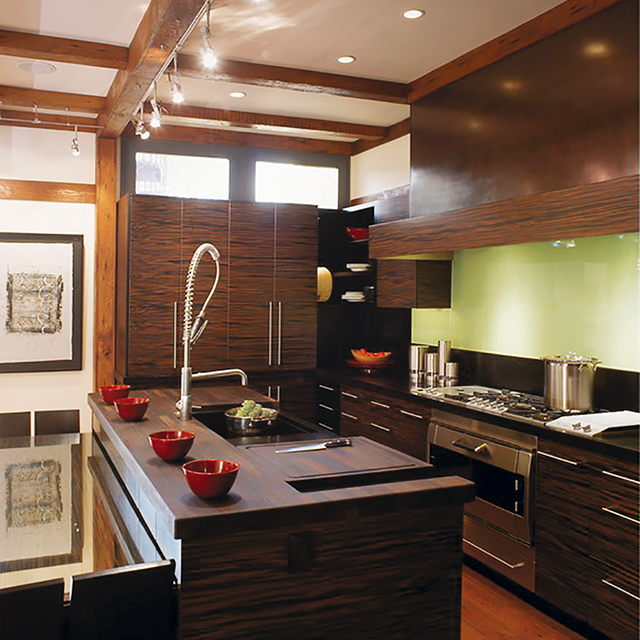
Designer Jennifer Gilmer proves that Japandi minimalism can be elegant and timeless, designing this kitchen with cabinetry crafted from Macassar Ebony, an engineered veneer.
Photos: OEO Studio
Japandi Meets Bungalow
Jennifer Gilmer, an award-winning kitchen and bath designer and principal of Jennifer Gilmer Kitchen & Bath with showrooms in Maryland and Virginia, says that she tells clients, jokingly, that she designs “Western Feng Shui” kitchens. “But I am really quite serious,” she remarks. “The more I learned about Feng Shui, the more I realized that I was unwittingly doing just that. It has become my signature style. So no matter what the design is, and they are all very different, the one thing they have in common is that they make you feel good. That’s Feng Shui.”
Japandi fans will testify to its built-in Feng Shui, so it’s no surprise that Gilmer chose modern Japanese design as the look she wanted for her own home. “This was a Sears bungalow,” she tells. “It was a far cry from the elegant minimalism of Japanese design, but my architect magically made my aspirations possible with a modern addition at the back of the house. There, I got the beautiful and functional space I had visualized for cooking, family life and entertaining.”
Knowing that the cabinetry would be the main focus of the kitchen, Gilmer sought out Premier Custom-Built Cabinetry, which has developed its Mizuki style inspired by Japanese folk houses and traditional Tansu cabinetry.
“We chose an engineered veneer crafted to look like Macassar Ebony,” relays Gilmer. “The wood grain is horizontal, and the ‘striped’ look is so striking that everything else in the kitchen was chosen to complement the cabinetry. No other element was allowed to distract from its beauty. For example, honed black granite was used for the countertops and wenge for the island wood detail. Wenge is similar to cherry, but turns dark over time. The backsplash behind the cooktop is backpainted glass, the farmhouse sink sits on black granite to protect the cabinets from water damage, and dishes are kept on floating shelves.”
She’s especially fond of the pantry, with its retractable bi-fold doors. They open to reveal a countertop, and it houses a steam oven as well as a plethora of cooking accessories. When not in use, the doors are shut so the pantry looks beautiful when entering the kitchen.
The gnarly irregularity of the unclaimed wood floors and beams contrasts with the clean, sleek cabinets, creating precisely the kind of juxtaposition that’s quintessentially Japanese. “So, yes, modern Japanese design and American Bungalow can mix well,” concludes Gilmer. “This space will never go out of style because it honored and melded two very tasteful styles that have proven the test of time.”
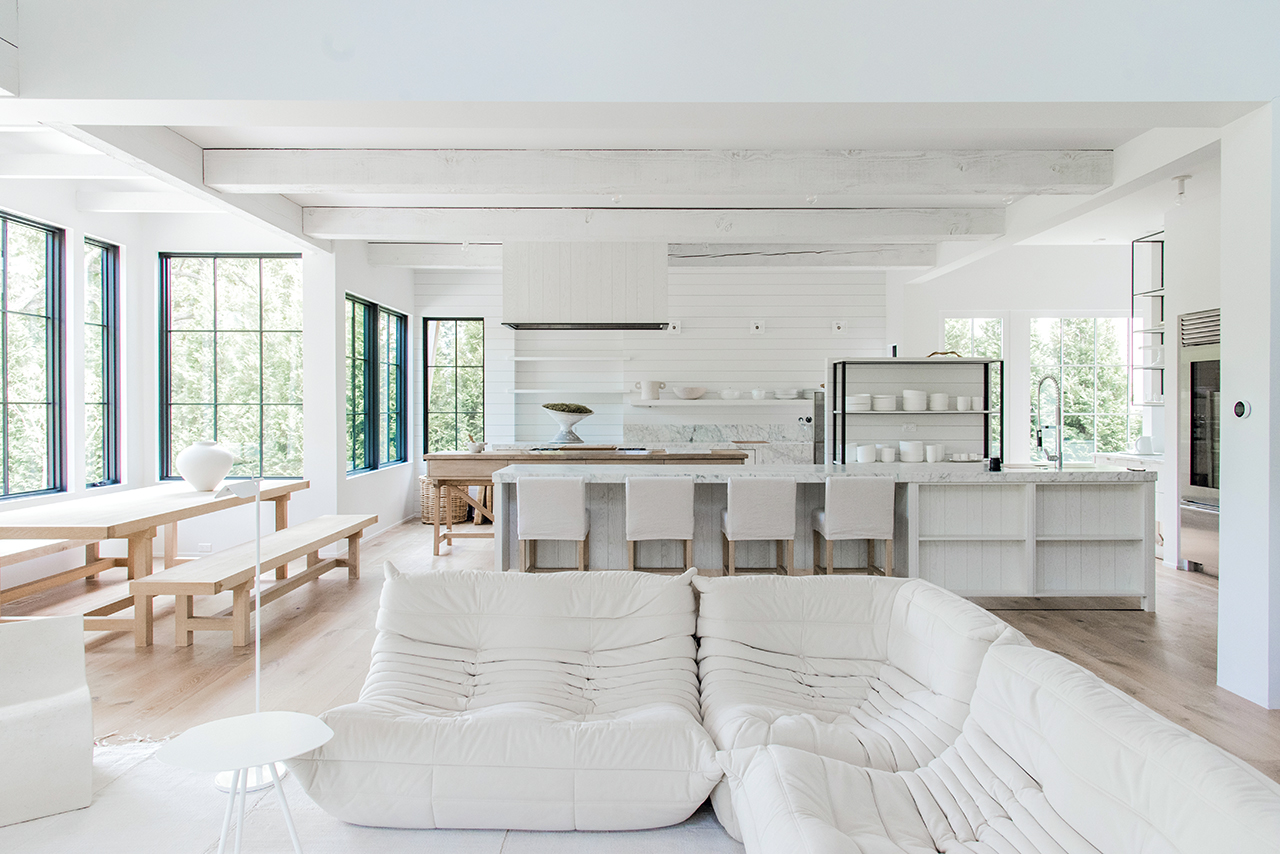
Neutral colors but strong texture contrasts of this Winnetka, IL open kitchen/family room/ dining area by Mick De Giulio reflect the design aesthetics of both Scandinavia and Japan.
Photo: Belen Aquino
Detailed Minimalism
Mick De Giulio, principal of de Giulio Kitchen Design in Chicago, IL, pays visits to near and far locales, and those influences have a way of creeping into his kitchen designs. Japanese and Scandi aesthetics may appear in a design here and there, but in typical De Giulio fashion, inspirations remain just that. From there they are carefully curated and translated into one-of-a-kind designs.
Such is the case of a kitchen he designed in Boston – a classic 19th-century Victorian with a modern addition in the back. “It was just right for a family friendly kitchen,” notes De Giulio. “It’s a contemporary, clean-lined space, but it blends seamlessly with the old part of the house, he remarks. “The design emphasizes asymmetry and horizontals, and the layout is straightforward. Materials play an important role in keeping the space serene. We used light walnut in an organic, almost natural color that we nicknamed ‘Norwegian’ for its sun-bleached, Scandinavian look.”
Of course, everything that De Giulio designs is actually not that simple. A kitchen may look minimalistic, but it’s sure to include exquisite details that don’t shout. The Boston kitchen’s cabinetry, for example, is framed in bronze and contrasts subtly with brushed Iceberg quartzite. The edges of the quartzite counter were mitered to make the slab look extra thick, and a stair-step design at one end provides room for extra seating. The quartzite is repeated on the backsplashes and wrapped the range area.
In another kitchen in Winnetka, IL, De Giulio, worked the wood, creating cabinets with seemingly unfinished, textured surfaces. The space was a riff on a style that the client called Belgian farmhouse, but it is also a look that’s beloved in Scandinavian and Japanese farmhouses. De Giulio achieved it using white oak, cross-cut against the grain. To emphasize the casual, freewheeling look of the light-filled space, he installed legs on the island and placed the cooktop on a table made of reclaimed wood. Finally, he introduced some freestanding stainless steel cabinets for a bit of an industrial vibe.
“There’s nothing sleek about this space,” comments De Giulio. “It is full of textures and juxtapositions. Nobody ever heard of Japandi when this kitchen was designed, but I think it plays into the style. It’s a strong style, especially because it is so adaptable.”
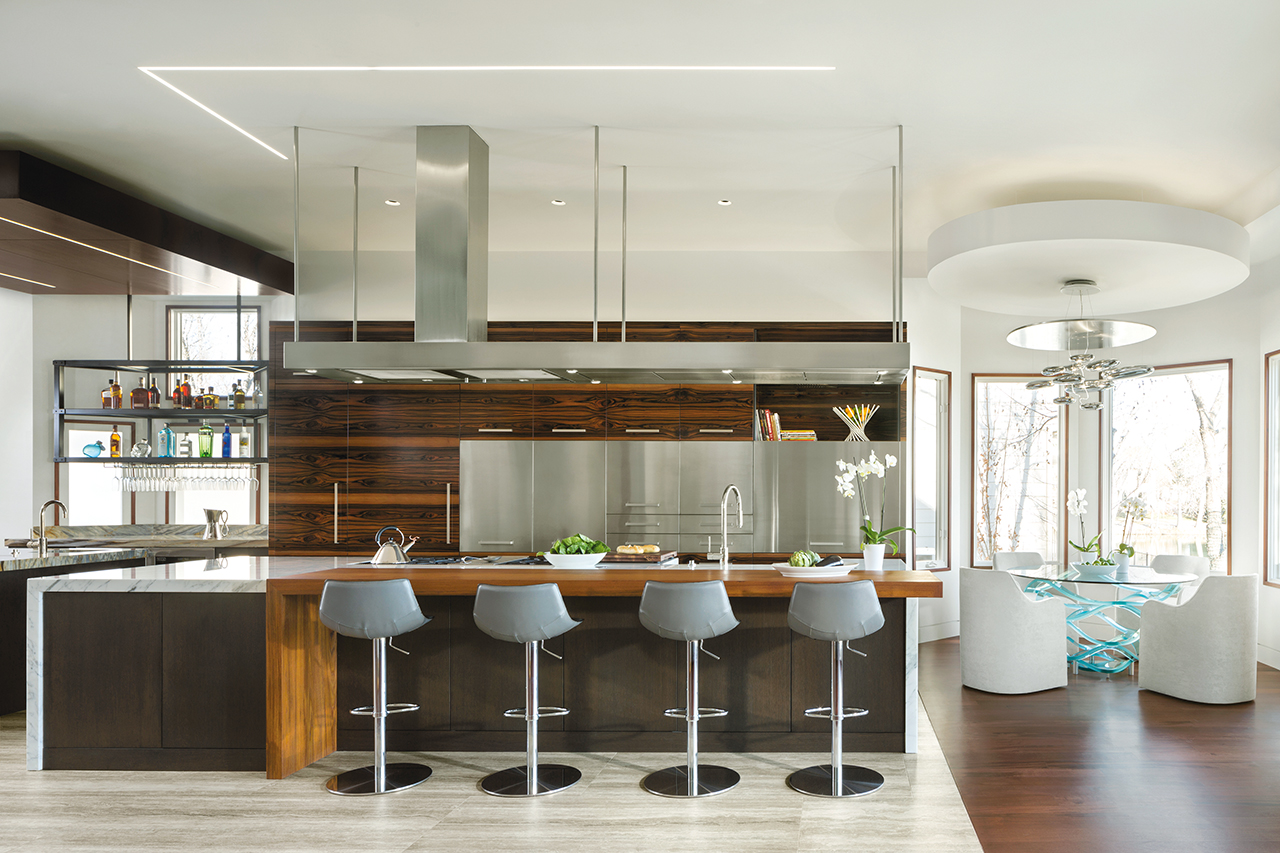
Marcus Otten calls the Royal Ebony veneer used for the cabinets in this kitchen the most beautiful he has ever seen, with unique colors and patterns that dictate that the cabinetry should be the key element.
Photos: Kimberly Gavin
Globetrotting Style
How do a couple of world travelers get a kitchen that reflects their global style, works as a canvas for treasures from many countries and yet functions for everyday life? They get together with award-winning designer Marcus Otten of Exquisite Kitchen Design in Denver, CO. Otten is known for a singular motto: “There are 10,000 different ways to do things, but only one way to do it right.”
For the world travelers, he designed a space where everything tells a story and brings up memories. The couple’s objets d’art are displayed throughout the space, including on floating shelves. The most stunning element, however, is the cabinetry featuring Royal Ebony veneer.
“It’s the most beautiful material I have ever seen,” remarks Otten. “It features unique color patterns and is very rare. There simply are no more logs. This African tree grows slowly and can only be turned into lumber when it’s 100 or so years old.”
Rift-cut oak for other cabinets and the island plus steel accents provide the layers and textures that Otten favors. Altogether, the space contains a lot of the Japandi influence: meticulous craftsmanship, beautiful wood, thoughtful contrasts and artistic accents.
Japandi’s elements are expected to continue to resonate with designers, who find its sophisticated minimalism warmed by craftsmanship and artistry endlessly adaptable. Many homeowners also understand and embrace the concepts of hygge and wabi-sabi, which Japandi fans call “yin and yang” at its best. Gilmer’s reference to it as “great Feng Shui” reflects its staying power in design. 
The post The Art of Japandi appeared first on Kitchen & Bath Design News.
Formica Corp. Accepting Entries For 2022 Student Competition
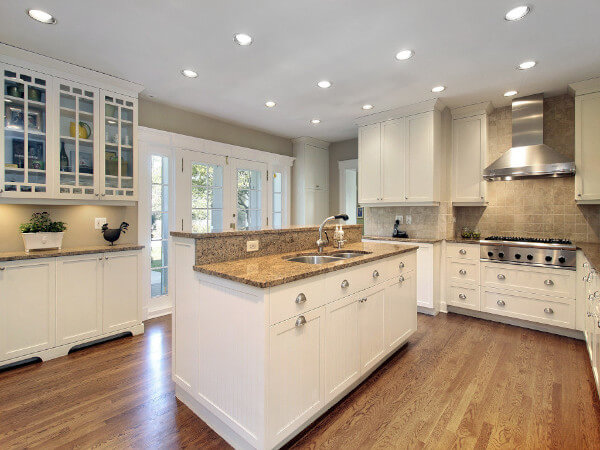
CINCINNATI, OH — Formica Corp. has announced the opening of the com- pany’s “FORM Student Innovation Competition,” an annual competition that will be marking its fifth anniversary in 2022.
The annual competition invites architecture and interior design students in the U.S. and Canada to showcase their creativity through original furniture designs that feature Formica Brand products. To celebrate its fifth anniversary, students will be asked to create their designs using Formica Brand woodgrain products, as a nod to the traditional fifth anniversary gift of wood.
Entrants have the chance to win cash prizes, earn national recognition and have their work showcased at NeoCon 2022, according to the Cincinnati-based Formica Corp. The competition is open through March 4, 2022, with winners announced in May of 2022, the company added.
Additional information can be obtained by visiting www.formica.com/ studentcompetition.
The post Formica Corp. Accepting Entries For 2022 Student Competition appeared first on Kitchen & Bath Design News.
Did you miss our previous article…
https://www.texaspiekitchen.org/?p=718